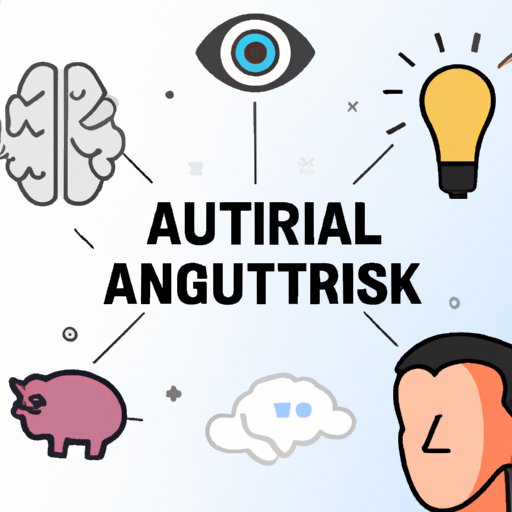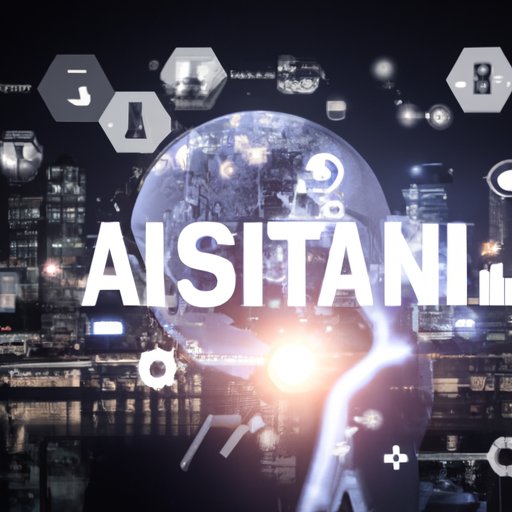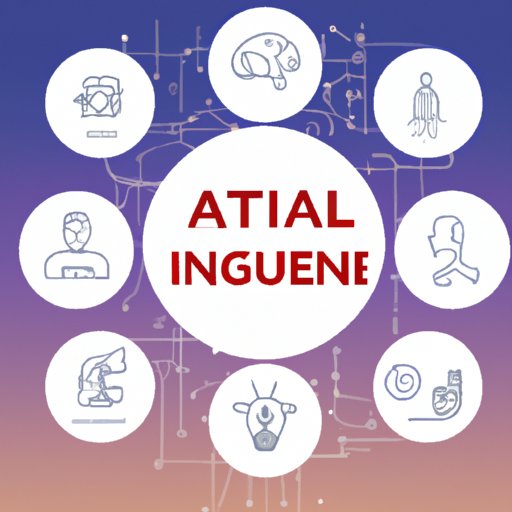Introduction
Artificial intelligence (AI) has become a buzzword in recent years, but what does it really mean and what does it consist of? This article will explore the components of AI and how they interact, look at its history and evolution, examine the benefits and challenges of AI, understand how AI is used in different industries, analyze the impacts of AI on society, and explore the future of AI and its potential impacts.
An Overview of AI Components and How They Interact
AI consists of several components that work together to create intelligent machines. These components include artificial neural networks, machine learning, natural language processing, computer vision, and robotics.
Artificial Neural Networks
An artificial neural network (ANN) is a system of interconnected nodes that imitate the way neurons in the human brain work. ANNs are used to process large amounts of data and identify patterns in it. They can also be used to make predictions based on the data.
Machine Learning
Machine learning is a subset of AI that uses algorithms to detect patterns in data and make decisions without being explicitly programmed. Machine learning algorithms can be supervised or unsupervised, meaning they can be trained with labeled data or unlabeled data respectively.
Natural Language Processing
Natural language processing (NLP) is the ability for a computer system to understand and process human language. NLP enables computers to read and comprehend text, as well as generate written responses. It is used in various applications, such as chatbots and virtual assistants.
Computer Vision
Computer vision is the ability for a computer system to interpret and understand images. Computer vision systems use algorithms to identify objects in images, as well as identify patterns in video footage. It is used in various applications, such as facial recognition and autonomous vehicles.
Robotics
Robotics is the use of automated machines to complete tasks. Robotics combines AI, computer vision, and machine learning to enable machines to move around, interact with their environment, and complete tasks autonomously.

Exploring the History of AI and Its Evolution
The concept of AI has been around for centuries, but the modern definition of AI was first introduced in 1956. Since then, AI has undergone several evolutions, from pre-WWII AI to post-WWII AI, to modern AI.
Pre-WWII AI
Before World War II, AI was mainly theoretical and focused on logic and mathematics. Alan Turing developed the Turing Test, which was designed to test if a machine could think like a human. However, there were no practical applications of AI during this period.
Post-WWII AI
After World War II, AI experienced a resurgence with the introduction of computer technology. Researchers began developing programs that could solve problems and make decisions. During this period, AI was mainly used in military applications and lacked practical applications in other areas.
Modern AI
In the past decade, AI has seen exponential growth due to advances in computing power and the availability of large datasets. AI has become more sophisticated and is now used in a wide range of applications, from healthcare to self-driving cars.
Examining the Benefits and Challenges of AI
AI has many potential benefits, but it also brings with it a number of challenges.
Benefits
AI can automate tedious and time-consuming tasks, freeing up humans to focus on higher-level work. AI can also be used to improve decision making and problem solving, leading to better outcomes. Additionally, AI can be used to analyze large amounts of data quickly and accurately, allowing for more informed decisions.
Challenges
One of the main challenges of AI is the lack of transparency. AI systems are often black boxes, meaning it can be difficult to understand why they make certain decisions. Additionally, AI systems can be prone to bias if not properly trained and monitored. Finally, AI systems require a large amount of data to function properly, which can be difficult to obtain.

Understanding How AI is Used in Different Industries
AI is used in many different industries, including healthcare, automotive, retail, and banking.
Healthcare
AI is used in healthcare to diagnose diseases, predict health outcomes, and streamline administrative tasks. AI systems can also be used to analyze patient data to develop personalized treatments and medications.
Automotive
AI is used in the automotive industry to develop autonomous vehicles. AI systems are used to process data from sensors and cameras to detect obstacles and safely navigate roads. AI is also used in semi-autonomous vehicles to assist drivers with tasks such as lane keeping and adaptive cruise control.
Retail
AI is used in retail to personalize customer experiences, optimize pricing, and automate inventory management. AI systems can also be used to analyze customer data to gain insights into customer behavior and preferences.
Banking
AI is used in banking to detect fraud, automate customer service tasks, and analyze customer data. AI systems can also be used to provide personalized recommendations and advice to customers, as well as automate loan approval processes.

Analyzing the Impact of AI on Society
AI has both positive and negative impacts on society.
Positive Impact
AI has the potential to improve healthcare, reduce poverty, and protect the environment. AI systems can help us better understand climate change and develop solutions to combat it. Additionally, AI can be used to automate mundane tasks, freeing up people to pursue more meaningful activities.
Negative Impact
On the other hand, AI can lead to job displacement and increased inequality. AI systems can also amplify existing biases and propagate them to wider audiences. Additionally, AI systems can be used for malicious purposes, such as hacking and cybercrime.
Exploring the Future of AI and Its Potential Impact
AI is expected to continue to evolve in the coming years, with potential impacts on society.
The Future of AI
AI is expected to become increasingly sophisticated, with AI systems able to interact naturally with humans. AI is also expected to become more decentralized, with AI systems operating independently of central servers. Additionally, AI is expected to become more secure, with improved cybersecurity measures.
Potential Impacts
The potential impacts of AI are vast. AI has the potential to revolutionize many industries, from healthcare to transportation. Additionally, AI has the potential to increase economic growth, reduce poverty, and improve quality of life. However, it is important to note that AI also has the potential to lead to job displacement and increased inequality.
Conclusion
In conclusion, this article explored what AI consists of and examined its components, benefits, challenges, and future potential. It looked at how AI is used in different industries and its impact on society. AI is an ever-evolving technology and has the potential to revolutionize many aspects of our lives. However, it is important to consider the potential implications of AI before implementing it.
(Note: Is this article not meeting your expectations? Do you have knowledge or insights to share? Unlock new opportunities and expand your reach by joining our authors team. Click Registration to join us and share your expertise with our readers.)
